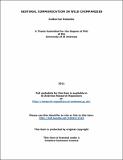Files in this item
Gestural communication in wild chimpanzees
Item metadata
| dc.contributor.advisor | Byrne, R. W. | |
| dc.contributor.author | Hobaiter, Catherine | |
| dc.coverage.spatial | 293 | en_US |
| dc.date.accessioned | 2012-01-04T11:59:53Z | |
| dc.date.available | 2012-01-04T11:59:53Z | |
| dc.date.issued | 2012-06-21 | |
| dc.identifier | uk.bl.ethos.552539 | |
| dc.identifier.uri | https://hdl.handle.net/10023/2143 | |
| dc.description.abstract | Great ape gesture is an elaborate, flexible system of intentional communication. It has been suggested that human language originated in gesture, thus, the gestural communication of great apes is of great interest for questions on the origin of language. To date, systematic studies of great ape gesture have been limited to restricted captive settings, supplemented by the study of a few specific gestures in wild populations. To address questions about gestural communication from an evolutionary perspective it is necessary to extend the systematic study of gesture into a wild ape population. I therefore undertook a 22-month study of gesture in the wild Sonso chimpanzee community in Budongo, Uganda. Sonso chimpanzees employ a large repertoire of species-typical gestures in intentional communication; a proportion of this repertoire appears to be ape-typical, as would be expected with a biologically given trait. Chimpanzees can acquire new behavioural patterns through imitation; however, this apparently does not represent a significant means of acquiring gestures. Gesturing was employed regularly in an intentional manner from the end of the first year, and was used by chimpanzees of all ages to communicate across a range of contexts, including the evolutionarily urgent context of consortship. Immature chimpanzees used a wide range of gestures, which they combined into rapid sequences. With maturity, use of the repertoire was ‘tuned’ to focus on the most effective gestures, which were then used individually. Despite the evidence for referential pointing in captive chimpanzees, there was little evidence for the regular use of it in wild chimpanzees. Gestures were used to communicate a range of imperative requests that regulated social behaviour. Chimpanzee gestures vary from the ambiguous to the highly specific in meaning; and, while gestures were used flexibly, they tended to be associated with a single dominant meaning. | en_US |
| dc.language.iso | en | en_US |
| dc.publisher | University of St Andrews | |
| dc.rights | Creative Commons Attribution-NonCommercial-NoDerivs 3.0 Unported | |
| dc.rights.uri | http://creativecommons.org/licenses/by-nc-nd/3.0/ | |
| dc.subject | Chimpanzee | en_US |
| dc.subject | Gesture | en_US |
| dc.subject | Great ape | en_US |
| dc.subject | Wild | en_US |
| dc.subject | Pan | en_US |
| dc.subject | Communication | en_US |
| dc.subject.lcc | QL737.P96H73 | |
| dc.subject.lcsh | Chimpanzees--Behavior | en_US |
| dc.subject.lcsh | Animal communication | en_US |
| dc.subject.lcsh | Gesture | en_US |
| dc.title | Gestural communication in wild chimpanzees | en_US |
| dc.type | Thesis | en_US |
| dc.type.qualificationlevel | Doctoral | en_US |
| dc.type.qualificationname | PhD Doctor of Philosophy | en_US |
| dc.publisher.institution | The University of St Andrews | en_US |
This item appears in the following Collection(s)
Except where otherwise noted within the work, this item's licence for re-use is described as Creative Commons Attribution-NonCommercial-NoDerivs 3.0 Unported
Items in the St Andrews Research Repository are protected by copyright, with all rights reserved, unless otherwise indicated.


